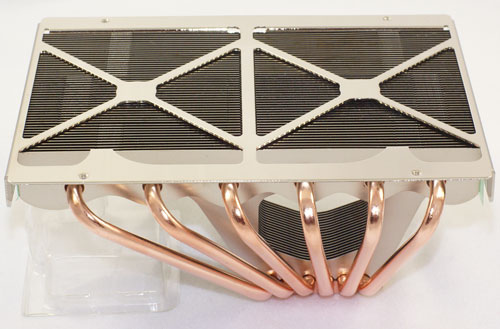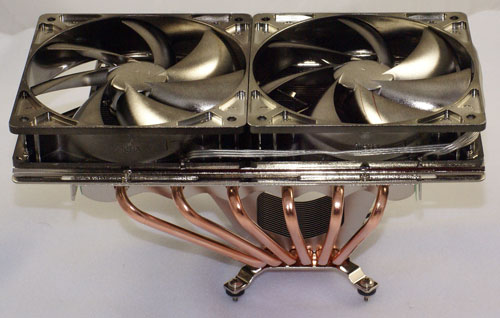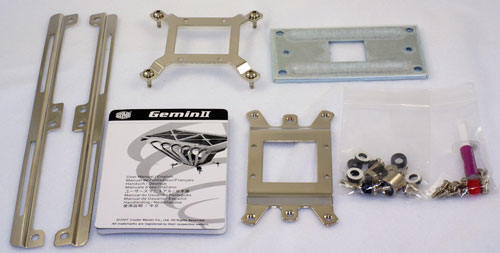Cooler Master GeminII: Performer or Poser?
by Wesley Fink on April 30, 2007 2:00 AM EST- Posted in
- Cases/Cooling/PSUs
Cooler Master Gemini II
Every enthusiast will probably recognize the Cooler Master name. As a leader in providing cooling solutions, Cooler Master has established themselves as a leading name in cases, air cooling, and fans. They also market products such as power supplies, water cooling kits, notebook cooling pads, and specialized chassis for external storage. If it comes to cooling, Cooler Master probably makes a product that competes for your attention.
Cooler Master makes a wide selection of CPU air coolers, ranging from budget alternatives to the stock CPU coolers that come with retail units to exotic high-end solutions. The GeminII currently sits at the top of the Cooler Master air cooling line.

For a cooler as large as the GeminII the packaging is amazingly compact. This is mostly because the Gemini II is shipped without any fans. In fact, Cooler Master claims the cooler can be used for fanless cooling if that is your goal.


The dark grey box is mostly filled with the GeminII heatpipe tower that is packaged in clamshell acrylic to protect the cooler from damage. The base cooler is quite heavy at 847g, which is almost 30 ounces before adding two 120mm fans.

The cooler comes with adapter kits for Intel socket 775 and AMD AM2/754/939/940. Strips for attaching and adjusting two 120mm fans and 8 fan screws for mounting the fans on the slide strips are also included. Preparing the GeminII for mounting is very easy, but you must remove the motherboard completely to mount the heat sink. We say completely remove because the only real way to install the GeminII is by turning the motherboard upside down and screwing the nuts onto the adapter which passes through the motherboard.
It is very important to carefully follow the instructions as there are different thicknesses of washers provided for attaching the GeminII. Some are adhesive and some are just spacers. You will need to make sure you install the correct washers in the correct locations. Our first install did not achieve a very good mating of the cooler base to the CPU top. It is very important to support the motherboard with a small box the height of the Gemini II or the PCIe video card. This allows the board to sit reasonably flat on the table and it makes it easier to get a solid install of the cooler base to the CPU.
While the GeminII is very large and heavy the installation through the board with screw and nuts is very secure. There are easier methods to attach a CPU but we doubt they would be as secure as the method chosen by Cooler Master.
Fans are not included with GeminII, so we chose a wide variety of fans for testing. For more information on the fans used for testing please check the details on page four.
Specifications
Our test system is Intel socket 775, but the Cooler Master GeminII will also mount on any AM2/754/939/940 CPU with the included adapters.
Any 120mm fan will fit the GeminII, regardless of the fan thickness or the post configuration.
Every enthusiast will probably recognize the Cooler Master name. As a leader in providing cooling solutions, Cooler Master has established themselves as a leading name in cases, air cooling, and fans. They also market products such as power supplies, water cooling kits, notebook cooling pads, and specialized chassis for external storage. If it comes to cooling, Cooler Master probably makes a product that competes for your attention.
Cooler Master makes a wide selection of CPU air coolers, ranging from budget alternatives to the stock CPU coolers that come with retail units to exotic high-end solutions. The GeminII currently sits at the top of the Cooler Master air cooling line.

For a cooler as large as the GeminII the packaging is amazingly compact. This is mostly because the Gemini II is shipped without any fans. In fact, Cooler Master claims the cooler can be used for fanless cooling if that is your goal.


The dark grey box is mostly filled with the GeminII heatpipe tower that is packaged in clamshell acrylic to protect the cooler from damage. The base cooler is quite heavy at 847g, which is almost 30 ounces before adding two 120mm fans.

The cooler comes with adapter kits for Intel socket 775 and AMD AM2/754/939/940. Strips for attaching and adjusting two 120mm fans and 8 fan screws for mounting the fans on the slide strips are also included. Preparing the GeminII for mounting is very easy, but you must remove the motherboard completely to mount the heat sink. We say completely remove because the only real way to install the GeminII is by turning the motherboard upside down and screwing the nuts onto the adapter which passes through the motherboard.
It is very important to carefully follow the instructions as there are different thicknesses of washers provided for attaching the GeminII. Some are adhesive and some are just spacers. You will need to make sure you install the correct washers in the correct locations. Our first install did not achieve a very good mating of the cooler base to the CPU top. It is very important to support the motherboard with a small box the height of the Gemini II or the PCIe video card. This allows the board to sit reasonably flat on the table and it makes it easier to get a solid install of the cooler base to the CPU.
While the GeminII is very large and heavy the installation through the board with screw and nuts is very secure. There are easier methods to attach a CPU but we doubt they would be as secure as the method chosen by Cooler Master.
Fans are not included with GeminII, so we chose a wide variety of fans for testing. For more information on the fans used for testing please check the details on page four.
Specifications
Our test system is Intel socket 775, but the Cooler Master GeminII will also mount on any AM2/754/939/940 CPU with the included adapters.
| Cooler Master GeminII Specifications | |
| Dimensions | 175(L) X 124.6W) X 81.5(H)mm (excluding fan) |
| Weight | 847g (excluding fan) |
| Material | Copper and Aluminum with soldered joints |
| Heatpipes | Six |
| Fan Configuration | Supports up to two 120mm fans (side by side) of any thickness |
Any 120mm fan will fit the GeminII, regardless of the fan thickness or the post configuration.










44 Comments
View All Comments
yyrkoon - Wednesday, May 2, 2007 - link
err, make that the second to the last page. Sorry.dm - Monday, April 30, 2007 - link
Nice review Wesley. I have owned this cooler and it does have its own merit. While it failed to beat the competition, what I can share is that I used this fan on an overclocked QX6700@3.2GHz at stock vCore and it performed great. If anyone would like to use it to achieve 3.8GHz+++, I suggest they get a quad core instead, say an X3210 and overclock it to 3GHz and use this cooler with a silent fan. With such cooling power, and since I have tested it personally, this cooler is great and should perform at par with competing ones.My only gripe is the price. The Ninja RevB I owned can cool the same quad core at same voltage but with much lower price tag.
joex444 - Monday, April 30, 2007 - link
This thing just got pwned. It's obviously a poser. All the extra fin space did nothing, and a 2nd fan proved to be a novelty.LaGUNaMAN - Wednesday, May 2, 2007 - link
Thanks for the review. I was waiting for this a long time. Definitely the best Gemini II review out there. (^^,)evident - Monday, April 30, 2007 - link
is it me or does thermalright xp/ultra/whatever 120 series own the competition constantly? every review i read this cooler dominates the market. I'm happy to own an xp-120 and that it's not getting topped anytime soon it seems :)stromgald - Monday, April 30, 2007 - link
Um, the XP-120 has been topped by the Ultra-120 (which is a completely different design than the XP), Scythe Ninja, and Zalman CNPS9500 to name a few. The Ninja barely edges it out, and the Ultra-120 beats the XP-120 by a good margin. The Zalman beats it in °C rise per W of processor heat, but is also noisier. Thermalright's good, but it's not like the competition is that far off at all.P.S. Thermalright doesn't have a 120 'series'. It's more like the XP series (XP-120, XP-90), SI series (SI-128, SI-97), and Ultra Series (Ultra-120, Ultra-90). The number is related to fan size, the name is the overall design/series.
Wesley Fink - Monday, April 30, 2007 - link
Thermalright has advised that the Ultra-120 eXtreme issues with the Socket 775 adapter have been resolved and the eXtrme is now in full production. For those who asked, the IFX-14 production has been delayed and Thermalright is now looking at an end of May release for the IFX-14.We will do an update on the performance of the production Ultra-120 eXtreme which is on its way to the labs.
TA152H - Monday, April 30, 2007 - link
Not to state the obvious, but shouldn't you have tested this thing with no fans? I mean, you get a heatsink with no fans at all, that says it can run with no fans, and kind of sucks when used with fans. Hmmmm, would kind of hit me like an airborne brick that I should probably test it without any fans at all, and see if it works. Cooler Master in my experience has been a pretty good company, and it makes me wonder why they made a cooler like this one that sucks so bad. Except maybe it doesn't, and for whatever peculiar reason is exceptional at running with no fans vis-a-vis other heat sinks with no fans. Of course, it could suck at that as well, but it's so obvious a question, I'm surprised no attempt was made to answer it. It could also be potentially useful. A sucky cooler like this is of little or no interest to people with fans, but if it cooled as well as a stock heat sink/fan, without the fan, that would be attractive to a much greater audience.I'm also surprised they are still making these massive beasts. With the death of the horrible P7, you'd think they would start making more reasonable sized heat sinks - unless they needed it this big to work fanless.
Wesley Fink - Monday, April 30, 2007 - link
We did try to test with no fans, but temperatures immediately ran to 70C under load at stock X6800 speeds and the system rebooted. I was not comfortable continuing a "no-fan" test under those conditions. perhaps this should have been mentioned in the review, but the results already pointed to less than stellar cooling efficiency compared to the Thermalrights, for example, which actually did fanless cooling within acceptable temperature ranges.As we have also stated several times, our current test bed is not well setup for testing fanless coolers. THe new test bed, which will be introduced with the 120mm fan roundup, is much better in that regard and will better support reliable, comparable results with fanless cooling.
TA152H - Monday, April 30, 2007 - link
OK, thanks.I think you should mention that in the article, because that was the first thing that popped into my head. "Can I use this thing fanless at stock clock speeds?"
With regards to the poor cooling, with some stuff it's bad to extrapolate data, even if it's logical. More specifically, it could be possible that one did better with fans, and another without, so I resist making assumptions on stuff like that. Put another way, if you were a designer, and I told you to make two heat sinks, one that was designed to work with a fan, and one that was designed to work without, would they end up being different? I would think so, but really I don't know enough to be sure. Consequently, I think stuff like that should be spelled out instead of assumed. In this case, it sucked at everything, but that may not always be the case.
Anyway, thanks for your response. I wouldn't want to ruin my processor either, so I can understand why you'd stop testing right away. I would have done the same.